BUICK LESABRE 1993 Owners Manual
Manufacturer: BUICK, Model Year: 1993, Model line: LESABRE, Model: BUICK LESABRE 1993Pages: 324, PDF Size: 17.02 MB
Page 251 of 324
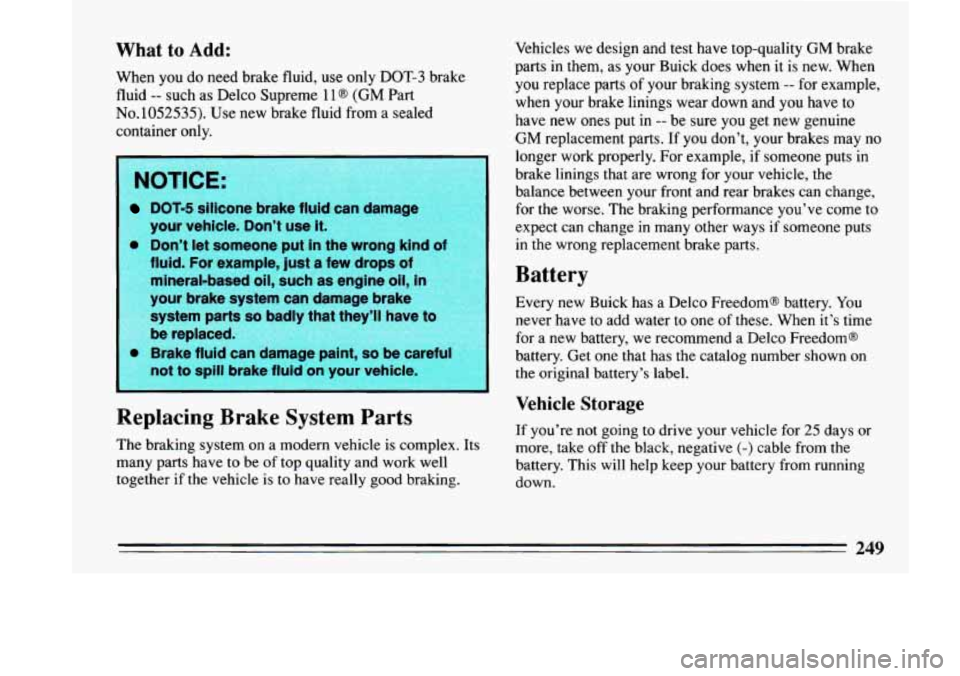
What to Add:
When you do need brake fluid, use only DOT-3 brake
fluid
-- such as Delco Supreme 11 @ (GM Part
No. 1052535). Use new brake fluid from a sealed
container only.
DOT-5 silic
your vehicle. Don’t use it.
0 Don’t let someone put in the wrong kind o
fluid. For example, just a few drops of
mineral-based oil, such as engine
oil, in
your brake system can damage brake
system parts
so badly that they’ll have to
Brake fluid can damage paint,
so be caref
Replacing Brake System Parts
The braking system on a modern vehicle is complex. Its
many parts have to be of top quality and work well
together if the vehicle is to have really good braking. Vehicles
we design and test have top-quality GM brake
parts in them, as your Buick does when it is new. When
you replace parts of your braking system -- for example,
when your brake linings wear down and you have to
have new ones put in
-- be sure you get new genuine
GM replacement parts.
If you don’t, your brakes may no
longer work properly. For example, if someone puts in
brake linings that are wrong for your vehicle, the
balance between your front and rear brakes can change,
for the worse. The braking performance you’ve come to
expect can change in many other ways if someone puts
in the wrong replacement brake parts.
Battery
Every new Buick has a Delco Freedoms battery. You
never have to add water to one of these. When it’s time
for a new battery, we recommend a Delco Freedoms
battery. Get one that has the catalog number shown
on
the original battery’s label.
Vehicle Storage
If you’re not going to drive your vehicle for 25 days or
more, take
off the black, negative (-) cable from the
battery. This will help keep your battery from running
down.
249
Page 252 of 324

A CAUTION:
Batteries have acid that can burn you and gas
that can explode. You can be badly hurt if you
aren’t careful. See
“Jump Starting” in the Index
for tips on working around a battery without
getting hurt.
I
Contact your dealer to learn how to prepare your vehicle
for longer storage periods.
Halogen Bulbs
1 6!& CAUTION:
Halogen bulbs have pressurized gas inside and
can burst if you drop or scratch the bulb. You or
others could be injured. Take special careowhen
handling and disposing of halogen bulbs.
I
Headlamp Bulb Replacement
a,
--.
Each headlamp is attached by retainers with round
plastic knobs. Remove the retainers
by turning in a
counter-clockwise direction.
250
Page 253 of 324
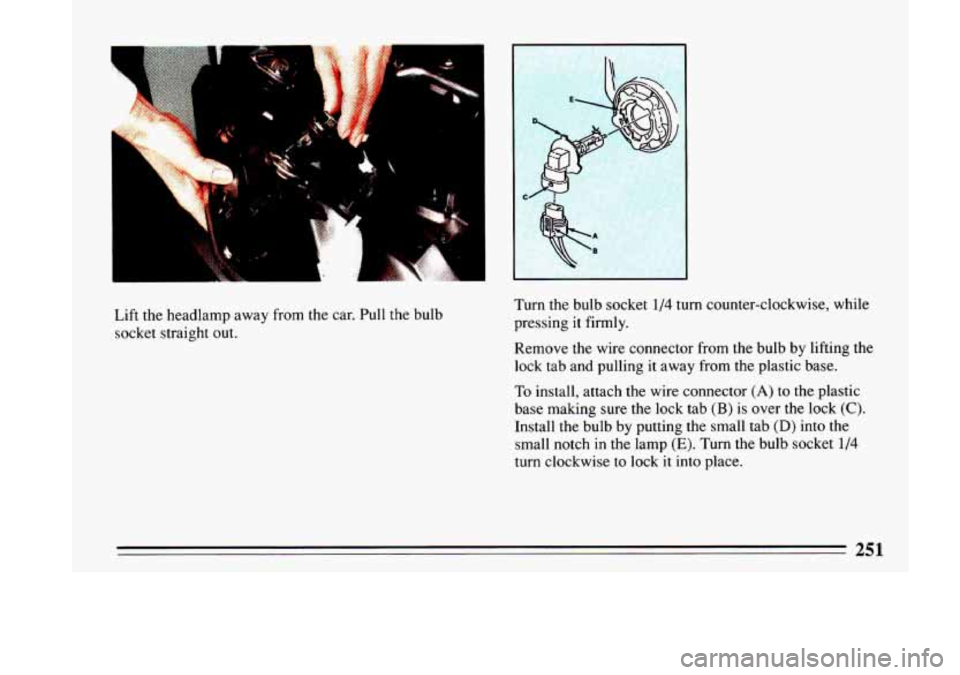
Lift the headlamp away from the car. Pull the bulb
socket straight out. Turn
the bulb socket 1/4 turn counter-clockwise7 while
pressing
it firmly.
Remove
the wire connector from the bulb by lifting the
lock tab and pulling it away from the plastic base.
To install, attach the wire connector (A) to the plastic
base making sure the lock tab
(B) is over the lock (C).
Install the bulb by putting the small tab (D) into the
small notch in the lamp
(E). Turn the bulb socket 1/4
turn clockwise to lock it into place.
251
Page 254 of 324
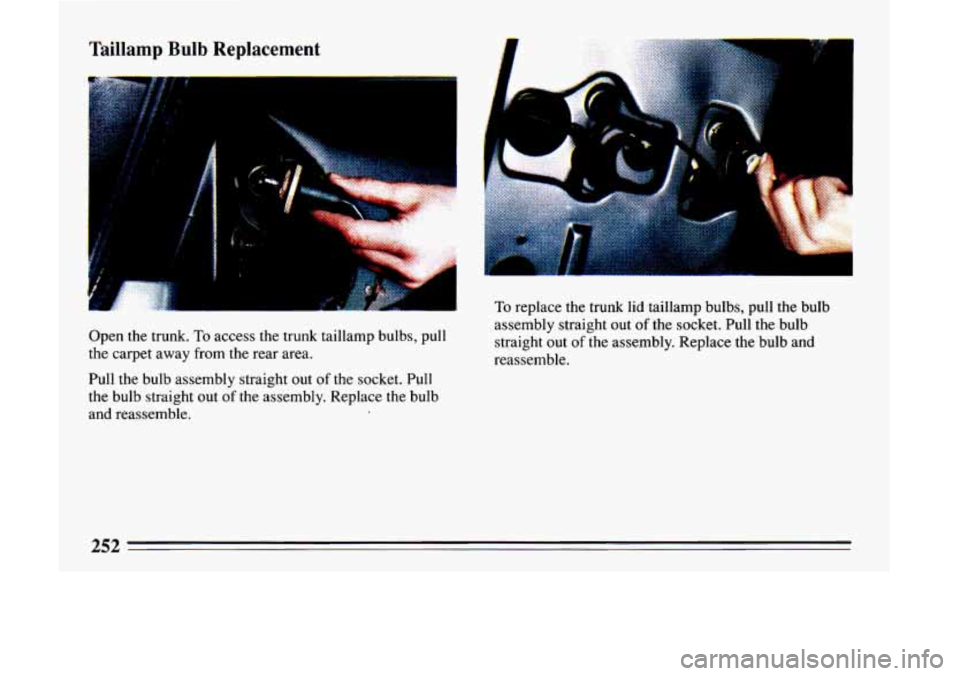
Taillamp Bulb Replacement
t -- .
Open the trunk. To access the trunk taillamp bulbs, pull
the carpet away from the rear area.
Pull the bulb assembly straight out
of the socket. Pull
the bulb straight out of the assembly. Replace the bulb
and reassemble.
To replace the trunk lid taillamp bulbs, pull the bulb
assembly straight out
of the socket. Pull the bulb
straight
out of the assembly. Replace the bulb and
reassemble.
3C3
Page 255 of 324
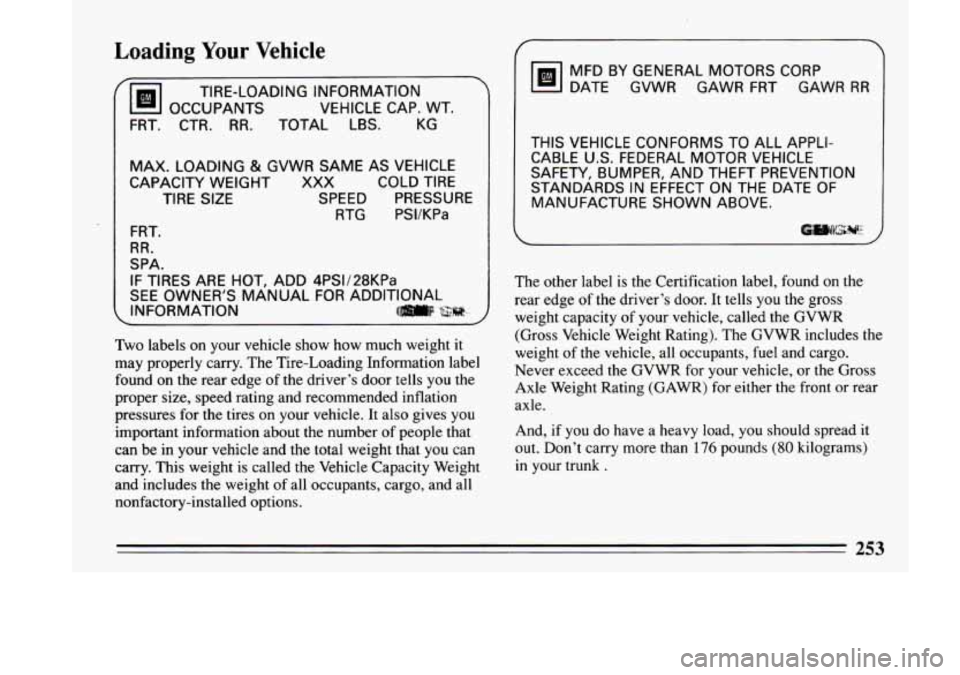
Loading Your Vehicle
TIRE-LOADING INFORMATION
OCCUPANTS VEHICLE CAP. WT.
FRT. CTR. RR. TOTAL LBS. KG
MAX. LOADING
& GVWR SAME AS VEHICLE
CAPACITY WEIGHT XXX COLD TIRE
TIRE SIZE SPEED PRESSURE RTG PSVKPa
FRT.
RR.
SPA.
IF TIRES ARE HOT, ADD 4PSV28KPa
SEE OWNER’S MANUAL FOR ADDITIONAL
, INFORMATION
Two labels on your vehicle show how much weight it
may properly carry. The Tire-Loading Information label
found on the rear edge of the driver’s door tells you the
proper size, speed rating and recommended inflation
pressures for the tires on your vehicle. It also gives you
important information about the number of people that
can be in your vehicle and the total weight that you can
carry. This weight is called the Vehicle Capacity Weight
and includes the weight of all occupants, cargo, and all
nonfactory-installed options.
MFD BY GENERAL MOTORS CORP
DATE GVWR GAWR FRT GAWR
RR
THIS VEHICLE CONFORMS TO ALL APPLI-
CABLE U.S. FEDERAL MOTOR VEHICLE
SAFETY, BUMPER, AND THEFT PREVENTION
STANDARDS IN EFFECT ON THE DATE
OF
MANUFACTURE SHOWN ABOVE.
The other label is the Certification label, found on the
rear edge of the driver’s door. It tells you the gross
weight capacity of your vehicle, called the GVWR
(Gross Vehicle Weight Rating). The GVWR includes the
weight of the vehicle, all occupants, fuel and cargo.
Never exceed the GVWR for your vehicle, or the Gross
Axle Weight Rating (GAWR) for either the front or rear
axle.
And,
if you do have a heavy load, you should spread it
out. Don’t carry more than
176 pounds (80 kilograms)
in your trunk .
Page 256 of 324

b, CAUTION:
Do not load your vehicle any heavier than the
GVWR or the maximum front and rear GAWRs. If
you do, parts on your vehicle can break, or it can
change the way your vehicle handles. These
could cause you
to lose control. Also,
overloading can shorten the life of your vehicle.
I
1
Your warranty does not cover parts or
components
that fail because of overloading.
If you put things inside your vehicle -- like suitcases,
tools, packages,
or anything else -- they will go as fast
as the vehicle goes.
If you have to stop or turn quickly,
or if there is a crash, they’ll keep going.
A CAUTION:
Things you put inside your vehicle can strike and
injure people
in a sudden stop or turn, or in a
eras h. 0
Put things in the trunk of your vehicle.
In a trunk, put them as far forward as you
can. Try to spread the weiqht evenly.
Never stack heavier things, like suitcases,
inside the vehicle
so that some of them are
above the tops
of the seats.
.I When you brry something inside the
vehicle, secure
it whenever you can.
0 Don’t leave a seat folded down unless you
need to.
254
Page 257 of 324
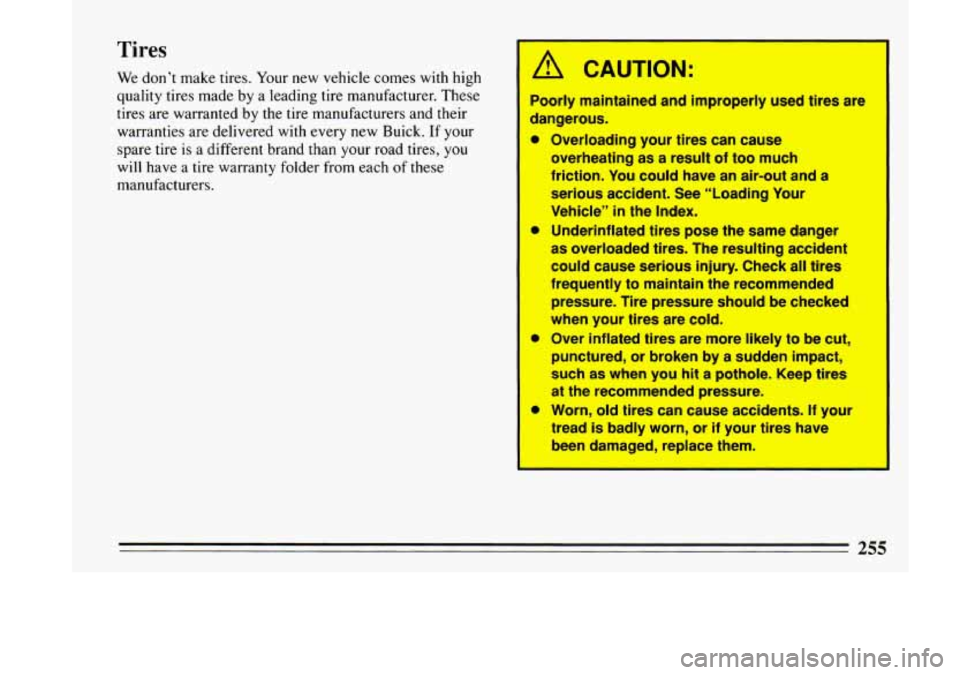
Tires
We don’t make tires. Your new vehicle comes with high
quality tires made by
a leading tire manufacturer. These
tires are warranted by the tire manufacturers and their
warranties are delivered
with every new Buick. If your
spare tire
is a different brand than your road tires, you
will have a tire warranty folder from each of these
manufacturers.
A CAUTION:
Poorly maintained and improperly used tires are
dangerous.
Overloading your tires can cause
overheating as
a result of too much
friction. You could have an air-out and a
serious accident.
See “Loading Your
Vehicle” in the Index.
Underinflated tires pose the same danger
as overloaded tires. The resulting accident
could cause serious injury. Check
all tires
frequently to maintain the recommended
pressure. Tire pressure should
be checked
when your tires are
cold.
Over inflated tires are more likely to be cut,
punctured, or broken by
a sudden impact,
such
as when you hit a pothole. Keep tires
at the recommended pressure.
Worn,
old tires can cause accidents. If your
tread
is badly worn, or if your tires have
been damaged, replace them.
255
Page 258 of 324
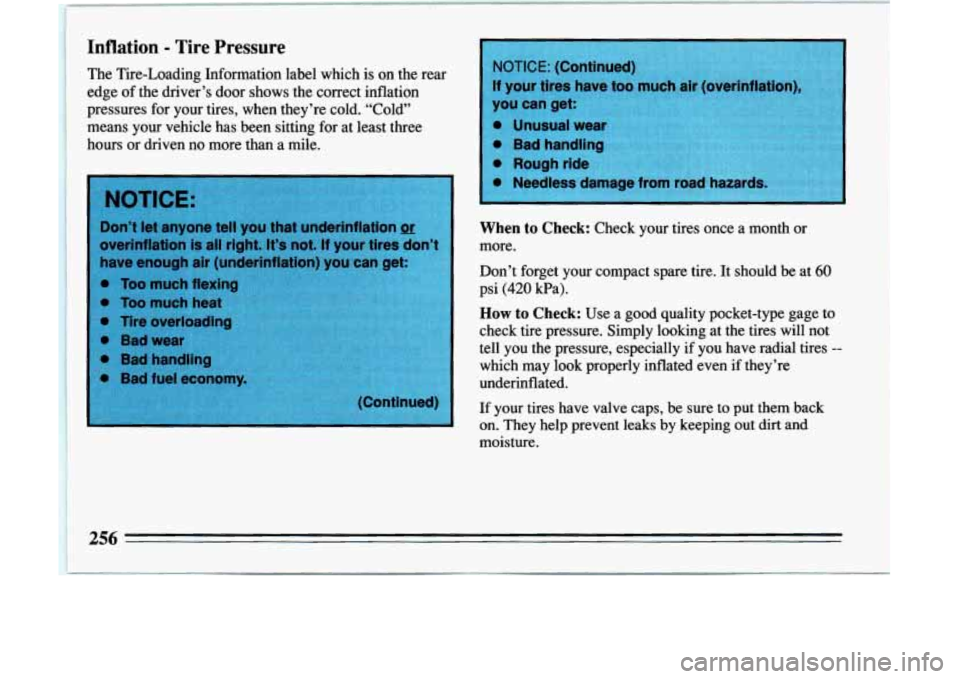
Inflation - Tire Pressure
The Tire-Loading Information label which is on the rear
edge of the driver’s door shows the correct inflation
pressures for your tires, when they’re cold. “Cold”
means your vehicle has been sitting for at least
three
hours or driven no more than a mile.
When to Check: Check your tires once a month or
more.
Don’t forget your compact spare tire.
It should be at 60
psi (420 Pa).
How to Check: Use a good quality pocket-type gage to
check tire pressure. Simply looking at the tires will not
tell you the pressure, especially if you have radial tires
--
which may look properly inflated even if they’re
underinflated.
If your tires have valve caps, be sure to put them back on. They help prevent leaks by keeping out
dirt and
moisture.
256
I
Page 259 of 324
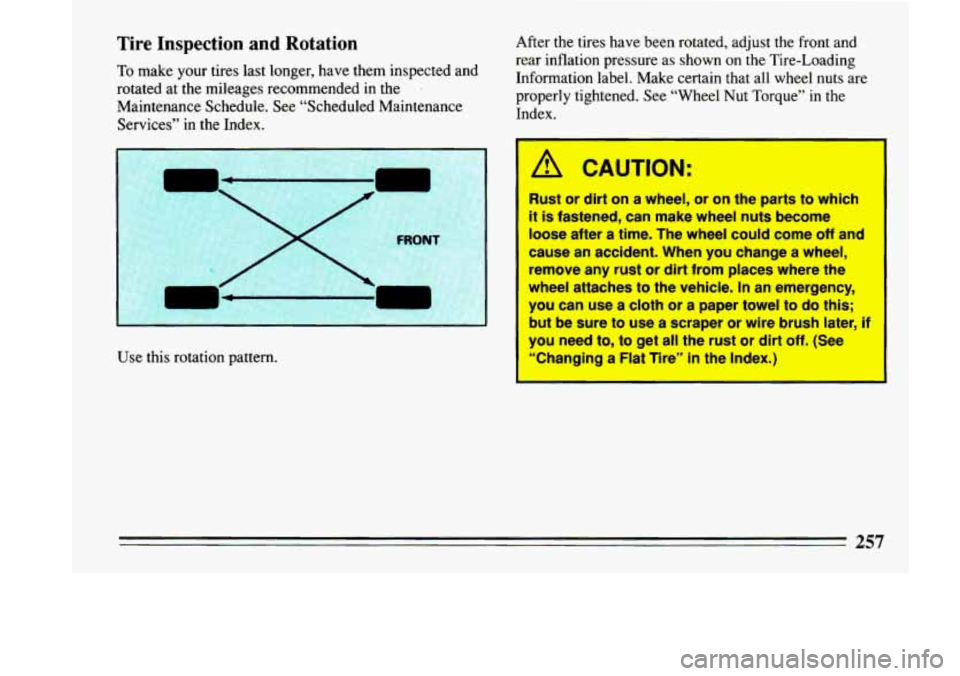
Tire Inspection and Rotation
To make your tires last longer, have them inspected and
rotated at the mileages recommended in the
.
Maintenance Schedule. See “Scheduled Maintenance
Services’’ in the Index.
Use this rotation pattern. After
the tires have been rotated, adjust the front and
rear inflation pressure as shown on the Tire-Loading
Information label. Make certain that all wheel nuts are
properly tightened. See “Wheel Nut Torque” in the
Index.
I
A CAUTION:
Rust or dlrt on a wheel, or on the parts to which
it is fastetfed, can make wheel nuts become
loose after a time. The wheel could come off and
cause
an accident. When you change a wheel,
remove any rust or dirt from places where the
wheel attaches
to the vehicle. In an emergency,
you can use a cloth or a paper towel to do this;
but be
sure to use a scraper or wire brush later, if
you need to, to get all the rust or dirt off. (See
“Changing a FI; Tire’* On the Index.)
Page 260 of 324
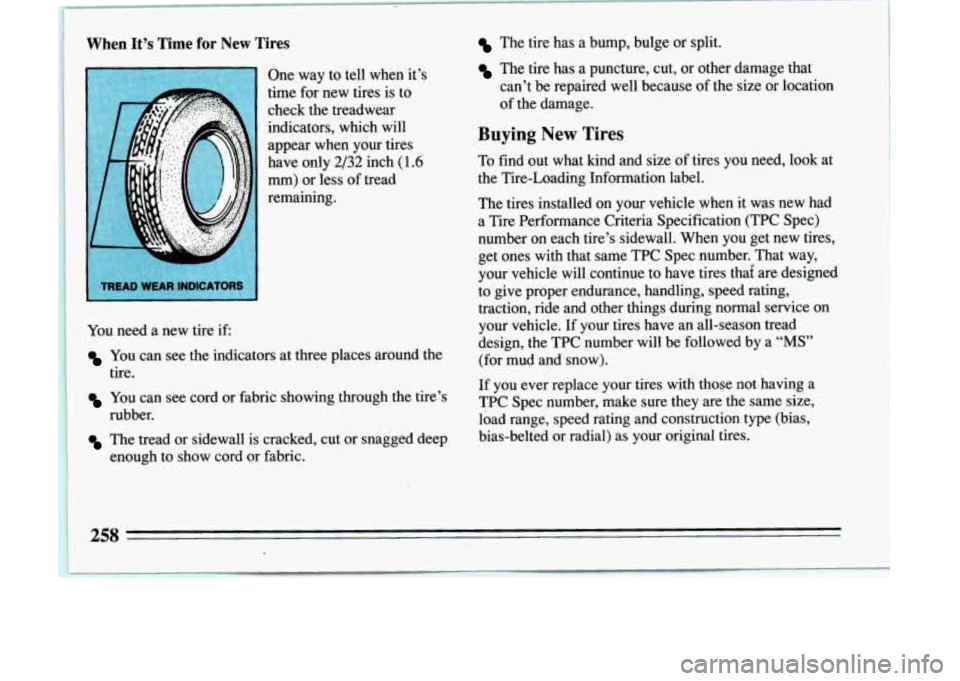
c:
The tire has a bump, bulge or split.
The tire has a puncture, cut, or other damage that can’t be repaired well because of the size or location
.
of the damage.
Buying New Tires
To find out what kind and size of tires you need, look at
the Tire-Loading Information label.
The tires installed on your vehicle when it was new had
a Tire Performance Criteria Specification (TPC Spec)
number on each tire’s sidewall. When you get new tires, get ones with that same TPC Spec number. That way,
your vehicle will continue to have tires that are designed
to give proper endurance, handling, speed rating, traction, ride and other things during normal service on your vehicle. If your tires have an all-season tread
design, the TPC number will be followed by a
“MS”
(for mud and snow).
If you ever replace your tires with those not having a
TPC Spec number, make sure they are the same size,
load range, speed rating and construction type (bias, bias-belted or radial) as your original tires.
TREAD WEAR INDICATORS
You need a new tire if:
you can see the indicators at three places around the
tire.
You can see cord or fabric showing through the tire’s
rubber.
The tread or sidewall is cracked, cut or snagged deep
enough to show cord or fabric.
258